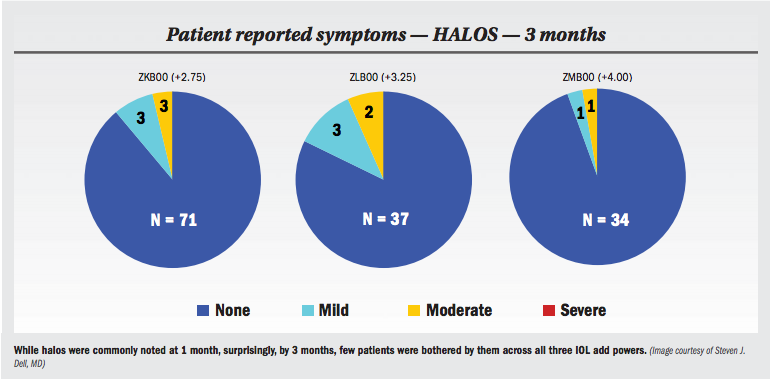Article
Maximizing multifocal IOL outcomes

Results of a prospective study find better visual acuity outcomes and higher patient satisfaction implanting a +2.75 D add multifocal IOL in the dominant eye and a +3.25 D add model contralaterally than when combining the +2.75 D model with a +4.0 D add multifocal IOL.
Combining two different power aspheric diffractive multifocal IOLs in fellow eyes provides better visual performance than implanting the same power lens bilaterally, and outcomes with the mixed approach are better using a lower add IOL in the non-dominant eye, said Steven J. Dell, MD.
Dr. Dell’s conclusions on maximizing functional outcomes with implantation of multifocal IOLs are based on findings from a physician-initiated multicenter study that included data from 82 patients who received the ZKB00 single-piece, diffractive aspheric +2.75 D add multifocal IOL (ZKB00; TECNIS Multifocal IOL +2.75 D, J&J Vision) in the dominant eye and either the +3.25 D add (ZLB00) or +4.0 D add (ZMB00) model of the same IOL in the non-dominant eye.
The results showed the +2.75 D/+3.25 D combination provided better near, intermediate, and distance uncorrected visual acuity (UCVA) and was associated with better overall satisfaction compared with the +2.75 D/+4.0 D approach. In addition, near UCVA in the +2.75 D/+3.25 D group surpassed that achieved in FDA registration trials evaluating bilateral implantation of the +2.75 D and +3.25 D add models, reported Dr. Dell, medical director, Dell Laser Consultants, Austin, TX.
“This prospective study was undertaken based on data showing an increase in patient satisfaction with multifocal IOLs as add powers have decreased. This may be due to lower incidences of photic phenomena, better intermediate vision, or both,” he said.
Dr. Dell’s co-investigators in the multicenter study were Farrell “Toby” Tyson, MD, Kevin L. Waltz, MD, and Jeffrey C. Whitsett, MD. Patients were eligible for participation if they had visual potential of 20/32 or better and were expected to have ≤0.5 D astigmatism postoperatively in each eye. Patients with ocular pathology known to affect VA, significant irregular astigmatism, or uncontrollable illness or disease were excluded.
Visual acuity was measured binocularly by a masked observer and under photopic conditions at far and intermediate distances and mesopic conditions for near. At 3 months, distance UCVA of 20/25 or better was achieved by 95% of patients in the +2.75/+3.25 D group and 83% of patients in the +2.75/+4.0 D group, while 20% of patients in the +2.75/+3.25 D group achieved 20/16 UCVA compared with only 8% of the +2.75/+4.0 D patients. The proportion of patients achieving distance UCVA of 20/20 or better in the +2.75/+3.25 D group was also comparable to that recorded in the FDA studies of the +2.75 D and +3.25 D add models and higher than that achieved in the FDA study of the +4.0 D add version.
Intermediate UCVA of 20/40 or better, 20/20 or better, and 20/16 or better was achieved by 93%, 22%, and 7% of patients, respectively, in the +2.75/+3.25 D group, and by 81%, 16%, and 0%, of patients, respectively, in the +2.75/+4.0 D group.
Near UCVA was 20/20 or better in 49% of patients in the +2.75/+3.25 D group, but in only 22% of patients implanted with the +2.75/+4.0 D combination. In the FDA trials where data were recorded at 6 months, only 25% of patients with bilateral implantation of the +2.75 D add multifocal IOL and only 35% of those receiving the +3.25 D add multifocal IOL bilaterally achieved 20/20 or better near UCVA.
Patient reported-outcomes
In the multicenter study of the mixed approach to multifocal IOL implantation, patients were asked about their ability to function without corrective eyewear. At 3 months in the +2.75/+3.25 D group, 78% of patients reported they had no difficulty and the rest noted having some difficulty, but none identified it as being extreme. In the +2.75/+4.0 D group, nearly three-fourths of patients said they had no difficulty functioning without corrective eyewear, but one patient reported having extreme difficulty and another indicated being unable to function without corrective eyewear
Results were also slightly better for the +2.75/+3.25 D group in the analysis of ratings of satisfaction with overall vision without corrective eyewear. Whereas nearly all patients in the +2.75/+3.25 D and +2.75/+4.0 D groups were either extremely satisfied or satisfied (95% and 91%, respectively), no patients in the +2.75/+3.25 D group were extremely dissatisfied, compared with 3% of those implanted with the +2.75/+4.0 D combination
Analyses of data on patient reported symptoms for each eye showed minimal problems with glare or starburst with any of the IOLs.
“We were also surprised to see very few reports of halos at 3 months with any of the IOLs. The rates were higher at 1 month, but halos were often resolved by 3 months and in no case did a patient describe the halos as severe,” Dr. Dell said.
Responses to a question asking whether the patient would recommend implantation of the IOLs received also favored the +2.75/+3.25 D combination-100% of patients in that group said they would make the recommendation compared with just 91% of patients implanted with the +2.75/+4.0 D add IOLs.
Disclosures:
Steven J. Dell, MDE: steven@dellmd.com
This article is based on a presentation given by Dr. Dell at the 2018 ASCRS Symposium. He is a consultant to J&J Vision.
Newsletter
Don’t miss out—get Ophthalmology Times updates on the latest clinical advancements and expert interviews, straight to your inbox.





